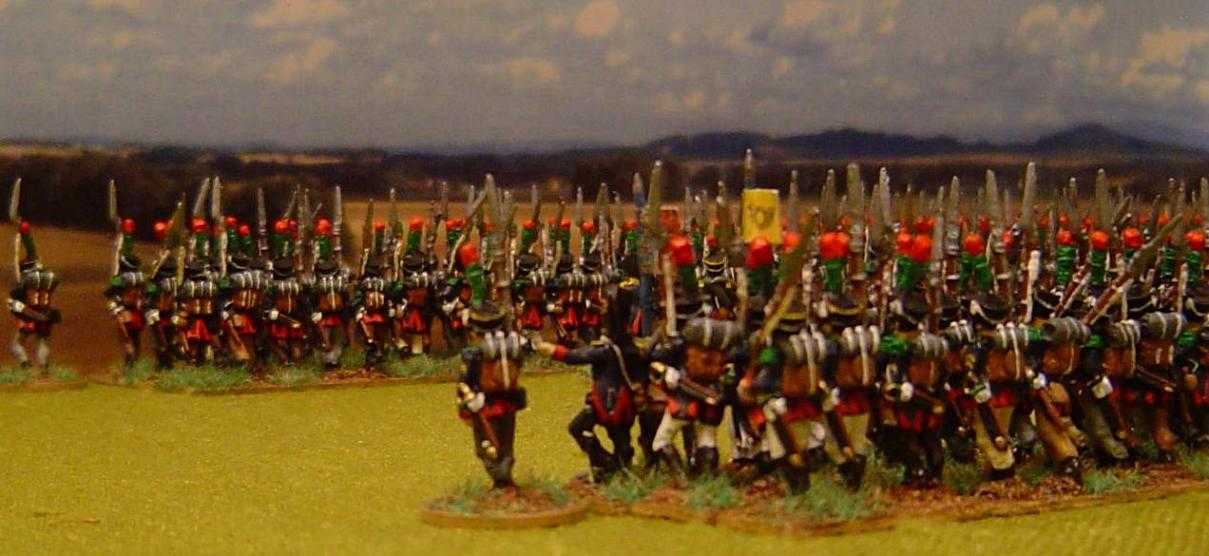Organisation tactique

L’unité tactique de base n’est pas la compagnie, mais le peloton. La compagnie est une entité administrative, le peloton est l’entité tactique.
Dans une situation optimale, un peloton sera formé d’exactement une compagnie. Mais bien souvent au sein d’un bataillon les compagnies n’ont pas toutes le même nombre de soldats dans leurs rangs, à cause des pertes subies en situation de guerre, ou tout simplement à cause des aléas du recrutement. Hors pour pouvoir exécuter les manœuvres sur le champ de bataille il importe que les pelotons présentent tous un effectif semblable, et ce afin de permettre la symétrie dans le déploiement et les évolutions.
Concrètement cela signifie que si la 1ère compagnie d’un bataillon compte 120 hommes et que la 2nde n’en a que 100, on formera le 1er peloton avec 110 hommes de la 1ère compagnie, et le 2nd avec les 100 hommes de la 2ème compagnie, renforcés par 10 hommes de la 1ère compagnie, afin de pouvoir faire manœuvrer deux pelotons égaux de 110 hommes chacun.
Pourtant les 10 hommes de la 1ère compagnie qui manoeuvrent avec le 2nd peloton ne sont pas pour autant transférés à la 2ème compagnie, et une fois les évolutions terminées, ils rejoindront leurs camarades de la 1ère compagnie.
Dans le cadre du bataillon de figurines, par un « heureux hasard » il se trouve que toutes les compagnies présentent un effectif égal, et chacune formera donc son propre peloton de manœuvre.
Au sein même de chaque peloton existe encore une sub-division tactique qu’il importe de mentionner, chaque peloton est en effet divisé en deux sections identiques, la section de droite étant la 1ère section, celle de gauche la 2nde.
Enfin, en plus des pelotons, on trouvera la garde du fanion, composée de 9 sous-officiers tirés des 4 compagnies du bataillon :
1 sergent-major portant le fanion
2 sergents
4 caporaux fourriers
2 caporaux
Les tambours des 4 compagnies sont également rassemblés à part, avec le caporal-tambour qui les commande et dirige.
A propos de la garde du fanion, je tiens tout de suite à préciser qu’elle est ici fantaisiste. En effet on peut voir, en plus du fanion réglementaire, un drapeau tricolore qui, si il fait très joli en avant du bataillon, est tout à fait contraire au règlement, et dont la présence est à vrai dire assez incongrue. Les régiments de Voltigeurs de la Garde n’ont jamais reçu d’Aigles, et leurs fanions se devaient de présenter un aspect le plus anodin possible (le rôle du fanion et de la garde qui l’accompagne est principalement de servir de guide au bataillon) afin de ne pas faire la joie de l’ennemi si celui-ci venait à s’en emparer. Il ne faut donc y voir là que la fantaisie du colonel du régiment… en l’occurrence moi-même !

The tactical unit is not the company, it is the platoon (peloton). The company is the administrative entity, while the platoon is the tactical one.
In an ideal situation, each platoon will be formed from exactly one company. But very often, within a battalion, the companies don’t have the same strength, because of casualties or of recruitment contingencies. Which would be source of problems if the companies were used as such on the field, because to be able to perform its various manoeuvres and formations, it is important for the battalion that all its platoons are of equal strength, in the purpose of symmetry.
In other words, it means that if the 1st company numbers 120 men and the 2nd company only 100, the first platoon will be formed with 110 men from the 1st company, while the second will be made up of the 100 men of the 2nd company, plus 10 men from the 1st company, so the two platoons will manoeuvre with 110 men each.
However the 10 men of the 1st company who manoeuvre with the 2nd platoon, these men are not transfered to the 2nd company, and at the end of the day, they will go back to the 1st company.
In our case, “luckily” all the companies are of equal strength, which means that each one of them will be able to form its own platoon.
Within each platoon is a tactical subdivision we need to mention : each platoon is divided into 2 sections of equal strengh, the right section beeing the 1st section, the left one beeing the 2nd section.
Finaly, we have the pennon’s guard, numbering 9 men from the 4 companies :
1 sergeant-major in charge of the pennon
2 sergeants
4 quartermaster corporal
2 corporals
The drummers of the 4 companies are gathered together with the corporal-drummer, who commands and leads them.
Talking of the pennon’s guard, I must precise that it is here very much eccentric. It has, not mentioning the pennon itself, a very nice three-coloured french flag, which presence is going very much against the regulations. The regiments of Guard’s Voltigeurs never received any Eagle, and their pennons’ role was tactical, the pennon and its guard having the role of leading the battalion and helping the soldiers in keeping their alignements and formations. Therefore the regulation specifies that it should not be decorated and not be three-colored, so that if it was to fall into the hands of the ennemy it wouldn’t make a nice trophee. One must see here only the will of the colonel of the regiment, meaning… myself !